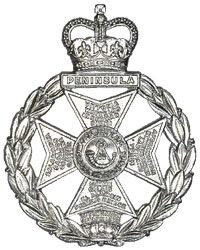History
The Royal Green Jackets was formed on 1 January 1966 by the amalgamation of the three separate regiments of the Green Jackets Brigade: [1]
There were also two Territorial Army battalions made up as follows: [2]
During the 1970s, 1980s and onwards up until the end of “The Troubles”, the battalions were deployed to various parts of Northern Ireland (Operation Banner). The 1st, 2nd and 3rd battalions were also based in West Germany, Osnabrück (1 RGJ), Minden (2 RGJ) and Celle (3 RGJ). [1]
The regiment's greatest loss of life at one time came on 20 July 1982, when seven RGJ bandsmen were killed by a Provisional Irish Republican Army bomb while giving a public concert in Regent's Park. The bomb exploded underneath the bandstand as the bandsmen played music from Oliver! to 120 spectators. [3]
In 1992, 1 RGJ was disbanded and 2 RGJ and 3 RGJ renumbered 1 RGJ and 2 RGJ respectively. [1] [4]
After the 1992 reorganisation, the unit was mostly based overseas in Dhekelia (Cyprus) and Paderborn (Germany), as well as in Northern Ireland. During the deployment of the 1st battalion to Episkopi Cantonment in Cyprus between October 1993 and May 1995, [1] three soldiers from the regiment were arrested and subsequently convicted for the killing of a Danish tour guide. [5]
The regiment also saw action in Bosnia and Kosovo during the Yugoslav Wars. Both battalions returned to the United Kingdom by 2002 and in 2003 the 1st Battalion served on Operation Telic 2 in Iraq. [1]
On 24 November 2005, the Ministry of Defence announced that the regiment would be amalgamated with The Light Infantry, the Devonshire and Dorset Light Infantry and the Royal Gloucestershire, Berkshire and Wiltshire Light Infantry to form a single large regiment to be called The Rifles. The reorganisation into The Rifles took effect on 1 February 2007 with the 1st Battalion Royal Green Jackets becoming the 2nd Battalion, The Rifles and the 2nd Battalion Royal Green Jackets becoming 4th Battalion, The Rifles. [1] The 1st Battalion The Royal Green Jackets' final operational tour was in Basra, in Iraq, on Operation Telic in 2006-07. [6]
Traditions
Their motto was Celer et Audax (Latin: "Swift and Bold"). As they were used as shock troops and marksmen, they had to get to the front line of battle as fast as was possible; as a result the RGJ marched at 140 paces per minute (at a 30" pace) whereas other regiments march at just 120. [8]
The regiment was classed as a 'rifle' regiment, having its lineage in the regiments of foot that were equipped with the first Baker rifles. Traditionally, rifle regiments wore rifle green tunics, an early form of camouflage, instead of the red jackets worn by line infantry, hence the regimental name. [8]
The cap badge was a Maltese Cross, which was drawn from the badges of the King's Royal Rifle Corps and The Rifle Brigade, with a combination of some of their battle honours on its arms. [8]
This page is based on this
Wikipedia article Text is available under the
CC BY-SA 4.0 license; additional terms may apply.
Images, videos and audio are available under their respective licenses.

